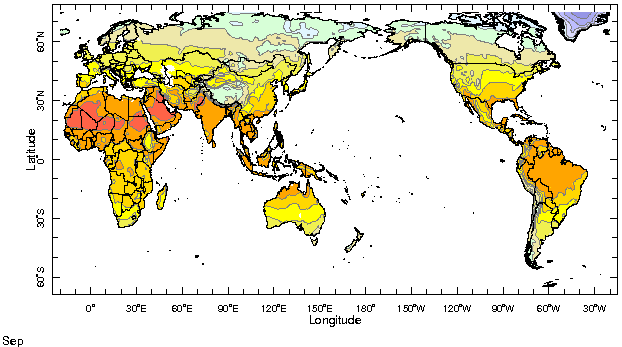|
IRI Climate Digest
October 2001
September Global Climate Summary
Climatological Background
During September, the Northern Hemisphere monsoon systems in West Africa, South Asia, and southwestern North America begin their retreat southward following the maximum solar heating which approaches the equator at the time of the equinox (September 21). Spring has begun in the Southern Hemisphere, with mid-latitude storm tracks losing strength.
Monthly Mean Temperature (1961-1990), data from the Climate Research
Unit, University of East Anglia


Monthly Mean Precipitation (1961-1990), data from the Climate Research
Unit, University of East Anglia


Temperatures
Warmer than average conditions continued over much of the continental land masses although central Europe, parts of the eastern United States and Siberia experienced cooler than average temperatures.
Europe: Northern Europe remained warmer than average, while the central region, including France and southern Germany were slightly cooler than average.
Asia: Near normal temperatures returned to much of central and northern Asia, while Siberia experienced cooler temperatures. Interior China and central India were slighter warmer than average.
Africa: Warmer than average temperatures continued over much of Africa.
Australia: Unusally warm temperatures continued in southeastern Australia.
North America: The western US and nearly all of Canada experienced warmer than average conditions, while eastern regions in the US were slightly cooler than average.
South America: Warmer than average conditions were recorded in Venezuela, eastern Colombia and much of Brazil.
Temperature Difference from the 1961-1990 mean, with data
from NCEP Climate Prediction Center, CAMS.


Precipitation
September marks the end of the monsoon rains in Africa, Asia and North America. In India the monsoon rains have been recorded at 92% of average for the season, while West African rains during the month were above average in much of the Sahel, with dry conditions along the Atlantic coast. The dry conditions in central America Continued.
Asia: Rainfall deficits persisted in the greater Mongolian region and northern and central China during September.
Africa: Much of the Sahel experienced above avverage rains, while tha Atlantic coast from Guinea to Ghana remained dry. In East Africa Uganda, northern Tanzania, Rwanda and Burundi received above average rainfall at the start of their season, while the Ethiopian highlands and the southern Somali and Kenyan coasts remained dry.
South America: Wetter than average conditions persisted in southern Brazil, Uruguay and northern Argentina.
North and Central America: Rainfall deficits continued over much of Mexico and Central America as well as the eastern seaboard of the US. Ontario and much of eastern Canada were also dry.
Europe: Wetter than average conditions prevailed over much of northern and eastern Europe.
Australia and New Zealand: In Australia, rainfall deficits occured along the Sydney coast, while in New Zealand, below-average rainfall persisted over the North and South Islands.
Precipitation Difference from 1961-1990 mean, with data
from NCEP Climate Prediction Center, CAMS-OPI.


Oceanic Conditions
Tropics: As in August, sea surface temperatures (SSTs) remained slightly above average across the central and eastern equatorial Pacific while slightly below average SSTs persisted in the eastern region. There continues to be little change in the equatorial Pacific and numerical models are suggesting near-neutral to slightly warmer than average conditions to persist over the next 6 to 9 months.
The anomalies of the tropical Indian and tropical north Atlantic oceans remain slightly above average.
Mid latitudes: In the central North Pacific, the unusally warm water continues to diminish as cooler than average conditions evolve to the north and south.
Monthly Sea Surface Temperature Difference from the 1950-1979 mean,
with data from the Environmental Modeling Center, NCEP/NOAA.


Contents |
Special |
Impacts |
Climate |
Forecast
|

